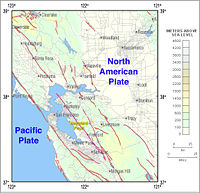
Photo from wikipedia
Existence of pulse at the beginning of the near-fault ground motions with forward directivity produces substantial amount of energy in a short period of time, which may cause brittle behavior… Click to show full abstract
Existence of pulse at the beginning of the near-fault ground motions with forward directivity produces substantial amount of energy in a short period of time, which may cause brittle behavior in structures affected by a sudden shock. Despite increasing mass constructions of tunnel form buildings (TFBs) all over the world, which may be located in near-fault regions, the lack of comprehensive and cogent investigation related to their seismic behavior is evident. This study is devoted to investigate the seismic performance of 5- and 10-story TFBs subjected to near- and far-fault ground motions through performing incremental dynamic analysis. In addition, their seismic responses considering two design hazard levels under both near- and far-fault ground motions are discussed. Results illustrate that with increasing the construction height and seismic intensity, the influence of directivity on the structural responses including story shear force, drift and damage get more intensified. In comparison with far-fault ground motions, the probability of reaching structural elements to preliminary damage levels is increased up to 20%. It appears in regions with high seismicity, existence of pulse with forward directivity in ground motions decreases structural reliability in high-rise TFBs at predefined performance objectives.
Journal Title: Asian Journal of Civil Engineering
Year Published: 2018
Link to full text (if available)
Share on Social Media: Sign Up to like & get
recommendations!